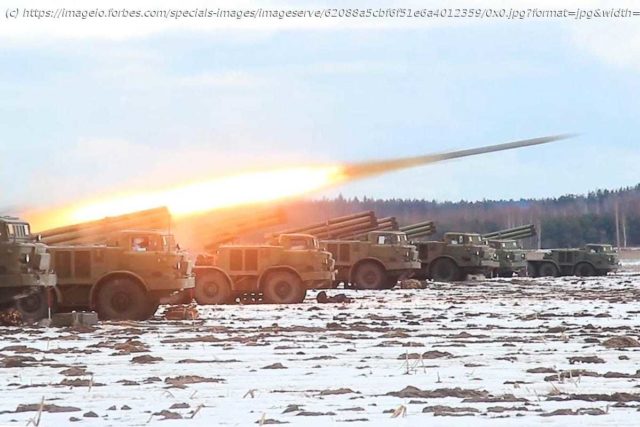Putin can call off his forces before hostilities commence. But nearly all the developments in 2022 show Russia’s military acting as if genuinely preparing for war with Ukraine. And by mid-February, the buildup appears nearly complete. Here are 12 indicators that explain analysts‘ dire predictions.
Last Friday, Biden administration officials revealed they now believed Russia was likely to undertake military action against Ukraine before the conclusion of the Olympic games, following a massive buildup of Russian ground and naval forces begun in the fall of 2021. Subsequently, the White House has ordered the withdrawal of diplomats and 150 U.S. military trainers in Ukraine and communicated to allies an attack might begin Wednesday (Feb 16.) As some of the White House assessment was based on intelligence from classified sources including signal intercepts, administration officials have refused to provide supporting evidence for fear of exposing the means used. Though Biden has stated clearly he will not send troops to defend Ukraine, some are mistrustful of Washington’s predictions, perhaps recalling how U.S. intelligence agencies furnished inaccurate intelligence on Iraq’s supposed WMD program in the early 2000s that resulted in the disastrous invasion of Iraq. However, between videos posted on social media and commercially available satellite imagery, there is more than ample evidence with which to conclude a Russian attack seems likely. Does this mean war is absolutely certain? No. Putin can still call off his forces before hostilities commence and then claim Washington was jumping at shadows. But nearly all the developments in 2022 show Russia’s military acting as if genuinely preparing to invade Ukraine. And by mid-February, the buildup appears nearly complete, with elements missing in the early stages falling into place. Let’s look at twelve indicators that explain the dire prospects security analysts see for the coming weeks. 1. Diplomatic engagement keeps on failing Unfortunately, multiple diplomatic encounters since January have made no headway. In the most seemingly positive exchange, assurances allegedly made by Putin in a meeting with French president Macron were walked back by the Kremlin the following day. NATO is willing to jointly implement arms control measures on medium-range missiles, reduce military patrols and exercises near Ukraine and improve transparency and communication. But these do not satisfy on Putin’s core demands: The first two provisions are so obviously unacceptable to NATO, some believe they were calculated to guarantee refusal. The third demand is Kyiv’s matter to decide, but per Russian media, Moscow may have thought Washington would twist Ukrainian Prime Minister’s Zelensky’s arm to follow such a policy. This proved inaccurate, and in recent Normandy talks, Ukrainian officials refused to meet in person with the separatists (viewed as puppets of Moscow). A subsequent Biden-Putin telephone call on Saturday has not yielded progress either. There is therefore little indication diplomatic efforts are going anywhere, or more importantly, that the Kremlin really wants them to. 2. Russia’s Duma will vote to formally recognize pro-Russian separatists on Ukrainian soil. Despite the ongoing war between Ukraine government forces and pro-Russian separatists in Eastern Ukraine, Ukraine’s military has been careful keep the temperature low in recent months to avoid incidents that could serve as a pretext for Russia to invade. This has apparently been frustrating enough that Moscow allegedly has been attempting to film a fabricated attack to justify a war, only for Washington to reveal intelligence on these schemes publicly on multiple occasions. Plans to hold a vote on February 15 in the Duma formally recognizing the self-proclaimed Luhansk and Donetsk separatist republics (the LPR and DPR), however, could be used to create a new legal basis for Moscow to intervene in Ukraine at the ‘invitation’ of these entities. 3. Moscow is evacuating most of its embassy in Kyiv Moscow has consistently claimed it has no intention of invading, but actions sometimes speak louder than words. It’s also advised most of the staff of its embassy in Kyiv to leave. According to spokeswoman Maria Zakharova: “…fearing possible provocations, we decided to optimize the staff of Russian foreign missions in Ukraine.” 4. Over half of Russia’s combat power is deployed around Ukraine Moscow has stripped military districts across Russia down to the bone to move mechanized units called Battalion Tactical Groups (BTGs) by rail into Belarus and reinforce Russian troops deployed around Ukraine. From the initial 30-35 BTGs permanently based close to Ukraine, military analyst Konrad Muzyka recently assessed Russia has deployed 90-95 of its 170 BTGs near Ukraine, a figure which has likely risen since.






